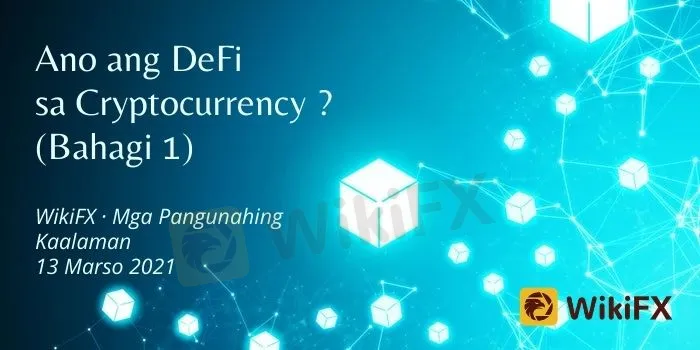简体中文
繁體中文
English
Pусский
日本語
ภาษาไทย
Tiếng Việt
Bahasa Indonesia
Español
हिन्दी
Filippiiniläinen
Français
Deutsch
Português
Türkçe
한국어
العربية
Ano ang DeFi sa Cryptocurrency ? (Bahagi 1)
abstrak:Pangunahing kaalaman tungkol sa cryptocurrency.

Mga Pangunahing Kaalaman sa WikiFX (13 Marso 2021) - Ang DeFi ay maikli para sa “desentralisadong pananalapi,” isang termino ng payong para sa iba't ibang mga aplikasyon sa pananalapi sa cryptocurrency o blockchain na nakatuon sa pagkagambala sa mga pampinansyal na tagapamagitan.
DeFi draws inspiration from blockchain, the technology behind the digital currency bitcoin, which allows several entities to hold a copy of a history of transactions, meaning it isn‘t controlled by a single, central source. That’s important because centralized systems and human gatekeepers can limit the speed and sophistication of transactions while offering users less direct control over their money. DeFi is distinct because it expands the use of blockchain from simple value transfer to more complex financial use cases.
Bitcoin and many other digital-native assets stand out from legacy digital payment methods, such as those run by Visa and PayPal, in that they remove all middlemen from transactions. When you pay with a credit card for coffee at a cafe, a financial institution sits between you and the business, with control over the transaction, retaining the authority to stop or pause it and record it in its private ledger. With bitcoin, those institutions are cut out of the picture.
Direct purchases arent the only type of transaction or contract overseen by big companies; financial applications such as loans, insurance, crowdfunding, derivatives, betting and more are also in their control. Cutting out middlemen from all kinds of transactions is one of the primary advantages of DeFi.
Before it was commonly known as decentralized finance, the idea of DeFi was often called “open finance.”
Mga Application ng Ethereum
Most applications that call themselves “DeFi” are built on top of Ethereum, the world‘s second-largest cryptocurrency platform, which sets itself apart from the Bitcoin platform in that it’s easier to use to build other types of decentralized applications beyond simple transactions. These more complex financial use cases were even highlighted by Ethereum creator Vitalik Buterin back in 2013 in the original Ethereum white paper.
That‘s because of Ethereum’s platform for smart contracts – which automatically execute transactions if certain conditions are met – offers much more flexibility. Ethereum programming languages, such as Solidity, are specifically designed for creating and deploying such smart contracts.
For example, say a user wants his or her money to be sent to a friend next Tuesday, but only if the temperature climbs above 90 degrees Fahrenheit according to weather.com. Such rules can be written in a smart contract.
With smart contracts at the core, dozens of DeFi applications are operating on Ethereum, some of which are explored below. Ethereum 2.0, a coming upgrade to Ethereum‘s underlying network, could give these apps a boost by chipping away at Ethereum’s scalability issues.
The most popular types of DeFi applications include:
Decentralized exchanges (DEXs): Online exchanges help users exchange currencies for other currencies, whether U.S. dollars for bitcoin or ether for DAI. DEXs are a hot type of exchange, which connects users directly so they can trade cryptocurrencies with one another without trusting an intermediary with their money.
Stablecoins: A cryptocurrency that's tied to an asset outside of cryptocurrency (the dollar or euro, for example) to stabilize the price.
Lending platforms: These platforms use smart contracts to replace intermediaries such as banks that manage lending in the middle.
“Wrapped” bitcoins (WBTC): A way of sending bitcoin to the Ethereum network so the bitcoin can be used directly in Ethereum's DeFi system. WBTCs allow users to earn interest on the bitcoin they lend out via the decentralized lending platforms described above.
Prediction markets: Markets for betting on the outcome of future events, such as elections. The goal of DeFi versions of prediction markets is to offer the same functionality but without intermediaries.
In addition to these apps, new DeFi concepts have sprung up around them:
Yield farming: For knowledgeable traders who are willing to take on risk, there's yield farming, where users scan through various DeFi tokens in search of opportunities for larger returns.
Liquidity mining: When DeFi applications entice users to their platform by giving them free tokens. This has been the buzziest form of yield farming yet.
Composability: DeFi apps are open source, meaning the code behind them is public for anyone to view. As such, these apps can be used to “compose” new apps with the code as building blocks.
Money legos: Putting the concept “composability” another way, DeFi apps are like Legos, the toy blocks children click together to construct buildings, vehicles and so on. DeFi apps can be similarly snapped together like “money legos” to build new financial products.

(To be continued ...)
Higit pang impormasyon tungkol sa mga nakatatandang mangangalakal na may karanasan sa 20 taon, mangyaring bisitahin ang WikiFX !
- Android: t.ly/4stP
- iOS: t.ly/cr7F

Disclaimer:
Ang mga pananaw sa artikulong ito ay kumakatawan lamang sa mga personal na pananaw ng may-akda at hindi bumubuo ng payo sa pamumuhunan para sa platform na ito. Ang platform na ito ay hindi ginagarantiyahan ang kawastuhan, pagkakumpleto at pagiging maagap na impormasyon ng artikulo, o mananagot din para sa anumang pagkawala na sanhi ng paggamit o pag-asa ng impormasyon ng artikulo.
Magbasa pa ng marami

Hulaan ng Klasikong Presyo ng Ethereum : Hulyo 21, 2021
Nagtatakda ang ETC ng yugto para sa 40% na pag-akyat.

Pagsusuri sa Pagmimina ng Bitcoin : Hulyo 19, 2021
Ginagawa ng Bitcoin ang kasaysayan habang itinatala ng BTC ang ika-apat na magkakasunod na negatibong pagsasaayos ng kahirapan sa pagmimina.

Pananaw sa Mga Cryptocurrency : Hulyo 19, 2021
Ang pananaw sa Bitcoin ay mananatiling negatibo.

Ang Industriya ng Pagmimina ng Bitcoin ay Nagpapakita ng Mga Palatandaan ng Pagbawi
Ang pangkalahatang rate ng hash ay nakabawi nang malaki sa huling linggo.
Broker ng WikiFX
Exchange Rate






